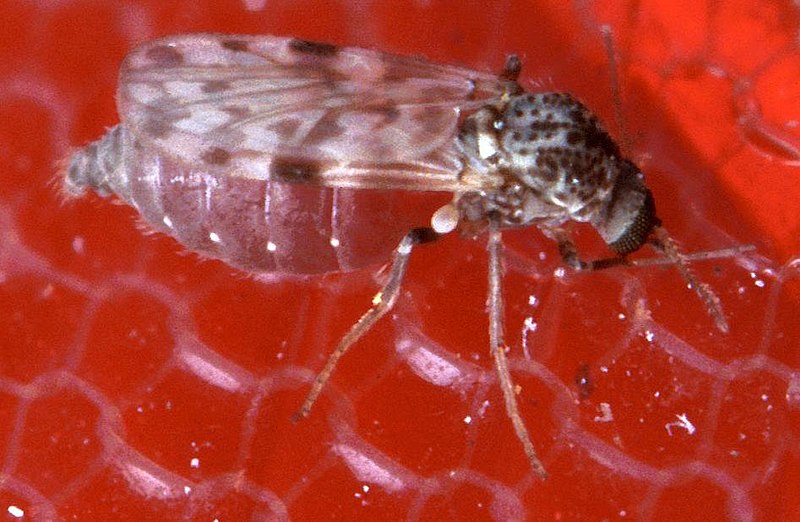 |
| Culicoidesa sixteenth-inch-long female biting midge (''Culicoides sonorensis'') feeding on blood delivered through artificial membrane developed for mass insect rearing |Source=Agricultural Resource Service: ([http://www.ars.usda.gov/is/g |
In using the cattle rubs, you need to compensate for this behavior. Cattle use back rubs by walking up to them in the pasture and rubbing on them. My deer don’t use them that way. I have to force them to utilize the rubs. Deer are different in behavior just like we humans. Some don’t mind the rubs on their backs but most do. Using the rub alone will result in poor success. You have to use ‘flyps’, the name for strips, made to attach to the rubs. The rubs I’ve seen using rope wicks don’t hold enough material. The flyps are made of thick polyester that stays very wet.
I ordered my back rubs from Jeffers Vet Supply using the rub and flyps. I use diesel and a permethrin product Ultra Boss. Ultra Boss also contains piperonyl butoxide. It is an organic compound that works as a synergist to make the permethrin last longer and makes it much more effective. It's marketed for cattle. As always, check with your veterinarian for their suggestions on using anything that may be off-label use. As a wildlife biologist with a lot of graduate study research on deer behavior, I’m ashamed to say I didn’t notice a very important indication of how effective it was. We’ve been using the rubs since 2009. Last year we were putting them up in May like we normally do. The mosquitoes had been so bad that we were breathing them into our noses. The deer had blood-filled mosquitoes all over their face and ears. A week after putting the rubs up we still had the mosquitoes swarming us but the deer were almost completely mosquito free! None of them had mosquitoes on their faces. The only place we saw any were on their lower legs and even then there would only be one or two. I should have noticed it years before. I believe the diesel is a repellant because the insecticide doesn’t have repellent properties. I used mineral oil instead of diesel on my breeder buck rubs to see if there was any irritation. The mineral oil didn’t have a noticeable difference on the skin, hair or antlers but I didn’t see the repellent properties. I even tried mixing citronella oil in the mineral oil but diesel works much better.
The deer have to be forced to go through the rub. My feeders have a 16x16 cover. I put deer fence wire around it and covered the wire with fabric to prevent injury in case they get spooked while inside. My water source is also in most of the enclosures.
I start out with a new rub, without the mixture, hanging as high as I can get it, usually 7 or 8 feet. I hang it where the deer will have to use an opening to go in for the food or water. After a day or so I'll start lowering it a little each day until I get it to the height I want. I let them use it at that height first. Then I charge it with the mixture. I haven't had any problems with the deer not using it. The key to success is using the flyps. I make my openings about 30-32” from the ground. I tie the rub along the bottom wire of the opening to prevent sagging. The flyps coat the deer with the mixture even for the ones that won’t touch their back on the rubs. It takes about 4 gallons of mixture for the new rubs. If you use last year’s rubs it takes about 2 gallons the first time. Keeping them wet takes about a gallon every week or two. I make sure my flyps have enough to drip at the bottom. I also buy extra flyps and tie them closer together. I want them close enough together to get the fawns too. Look at the pictures and check the links for Jeffer’s. Tractor Supply usually has some too but you may need more than they keep in stock.
GOOD LUCK! HOPE THIS HELPS!
 |
| I make opening about 32" from the ground so the flyps will be just a few inches off the ground. |
 |
| I start off with a new, dry rub w/o the diesel mixture. I lower it every day or so until I get it to the height I want. This allows the deer to get used to it. |
 |
| I keep the rubs wet enough to have the flyps drip the mixture from the ends. That way the animals get the mixture over most of their body. It also covers the fawns well. |
 |
| From this picture you can see Joey using the rub. This rub has been set up property so the flyps don't hang up on the wire. The flyps cover the deer from antlers to tail. |


